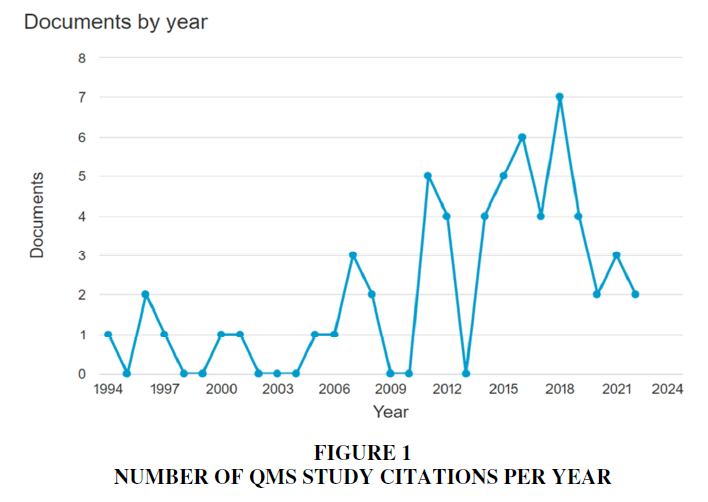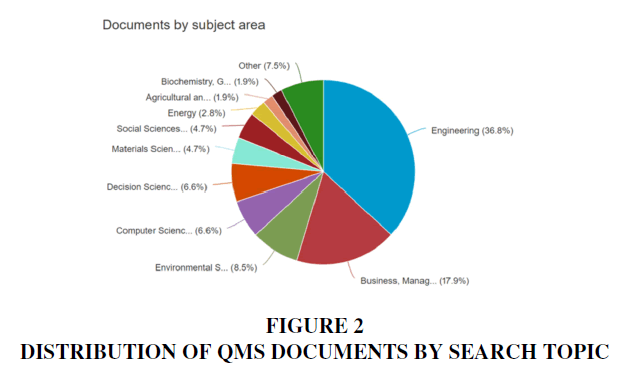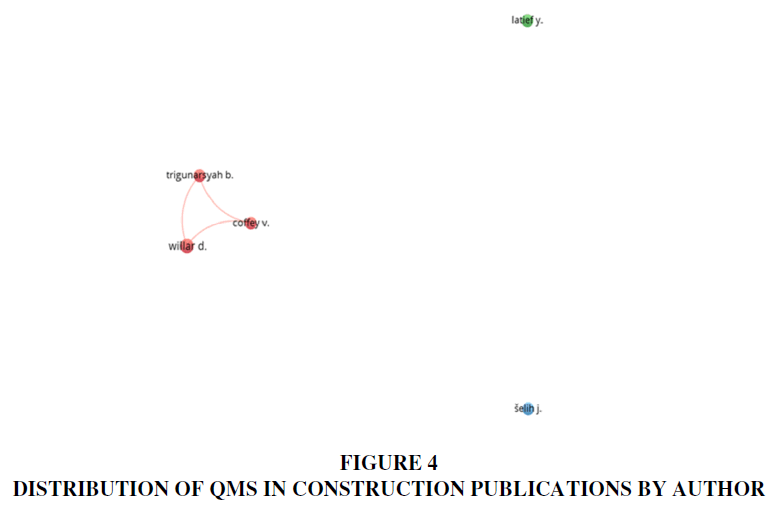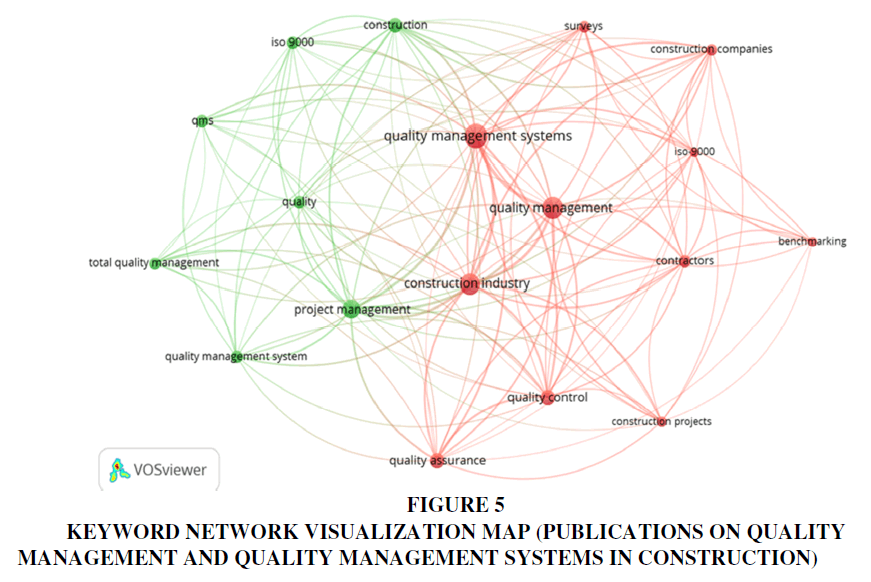Research Article: 2024 Vol: 23 Issue: 3
Quality management system in construction: a bibliometric analysis.
Bouzidi Yousra, University of Constantine 3 - Salah Boubnider
Louafi Samira, University of Constantine 3 - Salah Boubnider
Saighi Ouafa, University of Constantine 3 - Salah Boubnider
Citation Information: Bouzidi, Y, Louafi, S, Saighi, O. (2024). Quality management system in construction: a bibliometric analysis. Academy of Strategic Management Journal, 23(S3), 1-09.
Abstract
Purpose: The objective of our research is to analyze synergies between quality management system and construction industry, during the period between 1990 and 2023 Design/methodology/approach: Firstly, this study has adopted a dynamic and quantitative bibliometric method in web of science. Then, in order to highlight the correlation between quality management system and construction industry, we did a second search using the same keywords on google scholar Findings: In light of the results obtained, we deduce that there are many synergies between Lean Management tools and Industry 4.0 technologies Implications pratiques: The systematic review of quality management system in construction industry research enables us intuitively to obtain a panoramic view, including publication performance, thematic evolution and most influential topics of the field via a set of science maps, enabling future authors to investigate knowledge hiding and focus their research more effectively. Originality/value: The originality in this work lies in an in-depth examination of the relationship of the implementation of quality management system in the construction industry which has been briefly discussed by a few authors.
Keywords
Quality Management, Quality Management System, Construction Projects, Quality Control, Quality Planning, Quality Assurance.
Introduction
Quality can generally be defined as meeting or exceeding the legal, aesthetic, and functional requirements of an item, product, or service. In the construction industry, defining quality can be difficult, but it can be defined as meeting the requirements of designers, contractors, regulators, and owners. In public sector construction projects, the expectations of citizens and end-users are crucial. (Deming, 1986)
According to (Tan & Hamzah, 2005) From the perspective of a construction company, quality management of construction projects should mean maintaining the quality of construction work at the required standards to achieve customer satisfaction, which will bring long-term competitiveness and business survival to the company.
The concept of quality management is to ensure that efforts to achieve the required quality level of a product are well planned and organized.
According to (Arditi & Günaydın, 1997) Achieving acceptable quality levels in the construction industry has long been a problem. Significant amounts of time, money and resources, both human and material, are wasted every year due to inefficient or non-existent quality management procedures. The manufacturing industry has developed the Total Quality Management (TQM) concept, first applied in Japan and the United States in recent years, to increase productivity, reduce product costs, and improve product reliability. These concepts also apply to the construction industry. For example, Japanese construction companies benefited from the experience of Japanese manufacturers and began implementing TQM in the 1970s. Although construction is a creative one-time process, the Japanese construction industry has adopted the Total Quality Management (TQM) concept, which some believe is only suitable for mass production.
TQM has been adopted by major construction companies around the world based on their requirements and priorities to reduce costs, increase productivity and improve the health and safety environment in construction projects. Two studies of TQM by (Gamsby et al., 1996) and (Liu, 2003) found that overall motivation for implementing TQM remained essentially unchanged over three years. However, over the past three years, the methods and effects of total quality management implemented by various companies have varied greatly. Some companies abandon TQM implementation altogether, while others achieve award-winning results. Most construction companies focus on cost reduction rather than quality control and improvements.
In order to provide an overview of the articles published in the field of quality management, particularly quality management systems in construction projects, a bibliometric analysis was carried out.
Bibliometric analysis is the application of statistical and mathematical methods for the analysis of scientific publications in many disciplines and fields of study with a view to finding the most influential publications, journals, organizations, and countries (Yu et al., 2018) It also allows information to be analyzed in a more intuitive way by mapping and visualizing coupling networks such as co-author, co-citation ...etc
Several network visualization tools can be used in bibliometric analysis methods. In our study, bibliometric analysis is carried out using the Visualisation Of Similarities Viewer (Viewer, s.d.)
VOS Viewer is a software package developed at the Center for Science and Technology Studies (CWTS) at Leiden University (Netherlands), and is very popular for mapping and visualizing bibliometric networks.
These networks can include journals, researchers or individual publications, and they can be built on the basis of bibliographic coupling of co-citations or co-author relationships (Viewer, s.d.).
Methodology
The objective of our research is to identify articles describing the use of quality management system in construction industry, verifying the synergy between them to apply them in companies to ensure process improvement. To do this, we applied Tranfield’s systematic review method, which thoroughly examined the benefits and limitations of extending evidence-based research synthesis methods developed in construction research to the field of management. A systematic literature review includes the majority of the following steps:
1. Research design, 2. Compilation of bibliometric data, 3. Analysis, and interpretation of results with Special software VOSviewer, which provides a method for handling data more efficiently and easily, and helps with the visualization of search results.
The terms "quality management system" and "construction industry" was used.
The following query was formulated for the Web of Science (WoS) because it contains more than one billion search able cited references. In addition, in late 2015, WoS launched “Emerging Sources Citation Index” (ESCI), with more than 7000 journals covering scientific, social science, and humanities literature (ESCI, ISI Web of Knowledge by Clarivate Analytics [formerly known as Thomson Reuters]. Journals indexed in the ESCI do not obtain Impact Factors.
Moreover, in the continuously growing, dynamic and diverse literature, ESCI provides WoS users with extended possibilities to explore emerging research areas [53]. Our bibliometric search was carried out on 10/06/2022 and our search field was not limited by a specified duration or deadline.
Our bibliometric search was carried out on 10/06/2022 and our search field was not limited by a specified duration or deadline.
In the analysis, our search which included the following keywords: "Quality management", "Quality management system", "Construction industry", "Quality control", "Quality planning", "Quality assurance"; produced 59 results dated between 1994 and 2023. The results of both analyses are presented in the following sections.
Using the Web of science as a database, 3,969 publications with quality management systems in construction projects were found.
The main reason for the selection of this period (2011–2020) is that the notion of "Industry 4.0′" was adopted for the first time in 2011.The search initially generated 200 results in Web of Sci-ence, and in Google Scholar taking into account the title,abstract, and keywords. Of these references, 35 specificallyaddressed issues related to the relationship between Leantools and Industry 4.0 technologies that fit our criteria, dis-cussed in the next section. Table 2 and Fig. 8 provides a moredetailed classification of each research document examined
This bibliometric study aims to answer the following questions:
• What is the publication trend for articles relating to quality management in construction projects?
• What are the dominant sectors in terms of research into quality management systems?
• Which countries have contributed most to this research?
• What are the most influential publications in this field of research?
• What are the most frequently used keywords in quality management system research?
• All the data used in this bibliometric analysis were obtained from the ISI Web of Science (WoS) database.
Results and Discussion
Growth In Research: Evolution Of Research In Terms Of Quality Management Systems
Figure 1 shows the number of publications per year in this field between 1994 and 2023.
The figure 1 above shows the number of citations per year that these studies have received. It can be seen that the number of published studies on the quality management system in construction is increasing from 1994 to 2023; On the other hand, the number of publications during the year 2018 has experienced a remarkable decrease and reaches 2 publications, thereafter the rhythm of evolution returns with 3 publications during the year 2021. However, only 2 publications were found in 2023.
Document Distribution by Research Topic
This study proposes a list of documents published on the web of science database on QMS, as summarized in Figure 2 This analysis was carried out in order to determine the distribution of sectors in which the QMS under construction have been addressed. These results also showed the diversity of academic disciplines in which the QMS used. Overall, the distribution indicates that research is emerging in a variety of fields ranging from engineering, computer science, operations research management, business economics, automation control systems, environmental sciences... and so on. As indicated in the documents reviewed.
As shown in Figure 2, the top 3 sectors in terms of publications and research in quality management systems are engineering with 36.8%, followed by business and management with 17.9% and environmental science with 8.5%.
From these results we can see that the engineering sector is the most dominant in terms of research into quality management systems, which is quite logical given that quality is an important pillar and cornerstone for the success of construction projects.
The Management and Business sector, too, has seen a great deal of interest in quality management systems compared with other sectors. This can be justified by the fact that, in a competitive world where economic players are increasingly interdependent and their relationships more complex and evolving, companies need to rely on an optimized organization, a strong commitment from their staff and relationships of trust with their partners, such as the quality management system, to perform well and offer quality services to their customers.
Geographical distribution of quality management system publications
Figure 3 shows the geographical distribution of publications on quality management systems. From the figure, it can be seen that publications in this area of research are unevenly distributed, and that quality management and QMS have attracted a great deal of attention in Malaysia, America, Indonesia and the UK.
At the top of the list is Malaysia with a total of 13 articles, followed by the United States of America (USA) with 9 articles, Indonesia and the UK with 6 articles, Australia and Saudi Arabia with 4 articles and Slovenia and India with a total of 3 articles. Canada and Hong Kong are at the bottom of the list with a total of just 2 articles.
Top Contributors in This Field Of Research
With regard to the geographical distribution of publications on quality management systems in construction, Table 1 shows that Malaysia, the United States, Indonesia and the United Kingdom are the 4 major contributors in this field of research in terms of publications, with 13 articles published for Malaysia, 9 articles for the United States and 6 articles for Indonesia and the United Kingdom.
| Table 1 Geographical Distribution of QMS Publications in the Field of Construction | |
| Pays | Documents |
| Malaysia | 13 |
| United States | 9 |
| Indonesia | 6 |
| United Kingdom | 6 |
| Australia | 4 |
| Saudi Arabia | 4 |
| India | 3 |
| Slovenia | 3 |
| Canada | 2 |
| Hong Kong | 2 |
The modest number of contributions in this field can be explained by the fact that the notion of quality management systems in construction projects is very little addressed in the construction field, (lau & Tang, 2009) confirms this in their study which shows that contractors in the Hong Kong construction sector are less familiar with TQM.
Distribution of QMS Under Construction Publications By Author
Vaughan Coffey, bambang trigunarsyah and Debby Willar are the top 3 researchers with regard to our theme, as shown in the following figures.
Table 2 & Figure 3 provide information on the distribution of publications according to the authors who contributed to the literature. Thus, the first author who has contributed most to the literature with publications on "project management" and "quality management systems" is Debby Willar with 4 publications. Her contribution is followed by Vaughan Coffey,bambang trigunarsyah with 3 publications.
| Table 2 Authors with the Highest Number of Publications on Quality Management Systems in Construction Projects | ||||
| Number | Authors | Articles | Citations | Total link strength |
| 1 | Willar Debby | 4 | 76 | 6 |
| 2 | Vaughan Coffey | 3 | 75 | 6 |
| 3 | Bambang trigunarsyah | 3 | 75 | 6 |
| 4 | Jana Šelih | 3 | 56 | 0 |
| 5 | Yusuf Latief | 3 | 6 | 0 |
Keyword Network Analysis
The keywords obtained from the 3,969 articles studied were visualized using the VOS viewer software Figure 4.
An analysis of the keywords in the publications can provide information on the main research themes or QMS trends. Figure 5 shows the bibliometric network of term co-occurrence, with information on the 2 clusters or groupings, each corresponding to a different color.
Figure 5 Keyword Network Visualization Map (Publications on Quality Management and Quality Management Systems in Construction)
Associated keywords are indicated by different colored balls and are usually listed separately, but are closely related to each other.
The results presented in Table 3 show two main levels of ranking:
| Table 3 Comparison of Keywords By Occurrence | ||
| Key words | Occurrences | Total link strength |
| Quality management systems | 29 | 124 |
| Construction industry | 23 | 113 |
| Quality management | 26 | 102 |
| Project management | 18 | 87 |
| Quality controle | 13 | 64 |
| Quality assurance | 13 | 56 |
| Construction | 11 | 51 |
| Contractors | 9 | 48 |
| Construction companies | 7 | 46 |
| Iso-9001 | 5 | 36 |
| Quality management system | 8 | 34 |
| survey | 7 | 34 |
| Construction projects | 6 | 33 |
| quality | 9 | 29 |
| Iso 9001 | 8 | 27 |
| Total quality management | 7 | 25 |
| SMQ | 8 | 23 |
In the 1st rank; the most frequently cited words (over 100 citations) were divided into 11 groups: "quality management systems", "construction industry", "quality management", "project management", "quality control", "quality assurance", "construction", "contractors", "construction companies" and "ISO 9000" "With a frequency of occurrence of 29,23,26,18,13,13,11,9,7 and In the 2nd rank words that have a strong connection with each other and with the 1st rank keywords and also have a high occurrence in the quality management field: "quality management system", "questionnaires", "construction projects", "quality", "ISO 9000", "total quality management" and "QMS" with a frequency of occurrence of 8,7,6,9,8,7 and 8 respectively.
The size of the circles in the bibliometric network demonstrates the terms most present in the field, which are: quality management system, project management, construction industry. Table 3 also shows the number of occurrences of each term.
The term quality management system is the most recurrent, with 29 occurrences. On the other hand, "Construction industry" is the second most recurrent word (26 occurrences). Those agglomerating searches on our theme.
Conclusion
This study has explored existing publications in the Web of Science database on quality management systems in construction projects, offering an overview of the main aspects that characterize this area of research.
The subject of ISO 9001 quality management in construction projects has gained momentum over the last ten years, with 2018 being the year of the highest scientific output, indicating that the academic community's interest in developing research on this topic is growing. On the other hand, the three countries with the highest scientific output in the field are Malaysia, the United States and Indonesia. The latter are characterized by strong economic development. Finally, an analysis of the most recurrent keywords shows that quality management systems and the construction industry are two crucial central research areas for the term "quality management systems".
References
Arditi, D., & Günaydın, H. M. (1997). Total quality management in the construction process. International Journal of Project Management, 123-124.
Indexed at, Google Scholar, Cross Ref
Deming, W. E. (1986). Out of the crisis. Massachusetts Institute of Technology. Center for advanced engineering study, Cambridge, MA, 510(1986), 419-425.
Gamsby, S., Mize, J., & Reid, R. (1996). A project management focused frame work for assuring quality work process. the 27th Annual Seminar/ Symposium. Boston: Project Management Institute.
lau, A. w., & Tang, S. (2009). A survey on the advancement of QA (quality assurance) to TQM (total quality management) for construction contractors in Hong Kong. International Journal of Quality & Reliability Management, 410-425.
Indexed at, Google Scholar, Cross Ref
Liu, A. M. (2003). The quest for quality in public housing projects: A behavior-to-outcome paradigm. Construction Management & Economics, 147–158.
Indexed at, Google Scholar, Cross Ref
Tan, C.-K., & Hamzah, A.-R. (2005). Preliminary Research into Overcoming Implementation Problems of Quality Management in Construction Projects. Proceeding of the 4th Micra Conference (pp. 08-25). University Malaya: Faculty of the Built Environment.
Viewer, V. (s.d.). https://www.vosviewer.com/download
Yu, D., Wang, W., Zhang, W., & Zhang, S. (2018). A Bibliometric Analysis of Research on Multiple Criteria Decision Making. Current Science, 747-758.
Indexed at, Google Scholar, Cross Ref
Received: 05-Feb-2024, Manuscript No. ASMJ-24-14398; Editor assigned: 08-Feb-2024, PreQC No. ASMJ-24-14398(PQ); Reviewed: 22-Feb-2024, QC No. ASMJ-24-14398; Revised: 26-Feb-2024, Manuscript No. ASMJ-24-14398(R); Published: 29-Feb-2024




